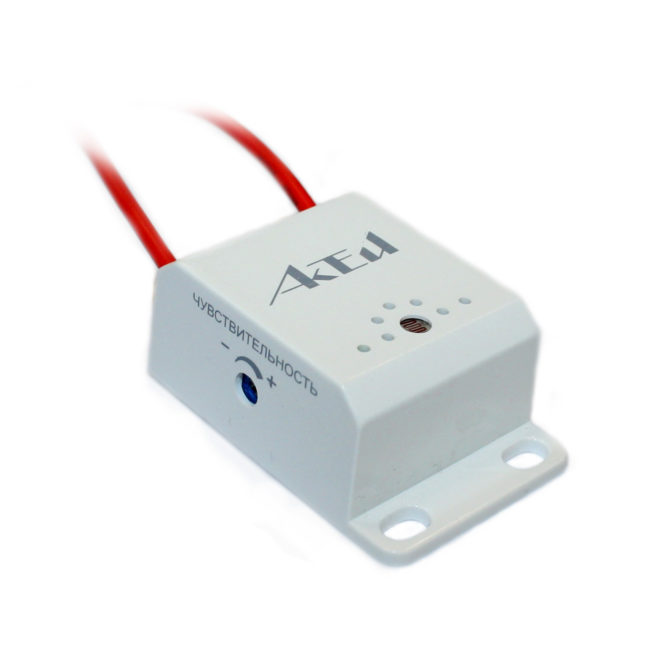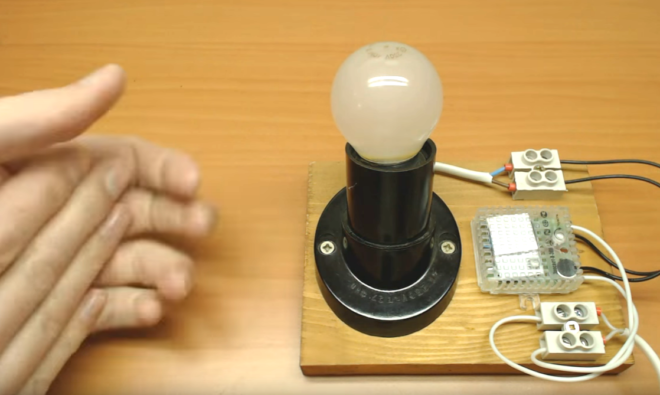Cotton (acoustic) switch

Previously, only in the cinema could we watch the hero of the picture enter the room, clap his hands and light up the light. For us, such an action seemed fantastic. Nevertheless, sooner or later, any fantastic inventions are embodied in real life. And the cotton switch is gaining more and more popularity now. But for most of us, it still remains beyond the boundaries of ideas and knowledge about electricity. We propose to get acquainted with such a switching device in more detail. Find out how it works, what is the principle of operation based on, where to buy it and is it possible to make such a switch with your own hands?
As yet, you can't go in and buy a device like a cotton switch at the first electrical store you come across. And not every manufacturer of household electrical appliances produces such devices. The most famous company that produces these devices is the Minsk firm Nootekhnika of the Republic of Belarus. We will study the sound switch using the example of the Ecosvet-X-300-L switch developed by Belarusians.
Where is it applied?
 The cotton switch works with different lamps - fluorescent, incandescent, energy-saving, halogen, LED.
The cotton switch works with different lamps - fluorescent, incandescent, energy-saving, halogen, LED.
For its normal functioning, the voltage level in the network must be 220 V, the power of the lighting load must not exceed 300 W, the permissible temperature is from -20 to +40 degrees.
The cotton switch is not larger than a regular matchbox, so it can easily be placed in the base of any lighting fixture.
The cotton light switch is recommended to be installed in rooms with a relatively low noise level. For example, in living and storage rooms, basements and outbuildings. If it will be some kind of office space, workshops or production sites, where extraneous sharp and loud noises are constantly present, a false alarm of the device is possible.
It is best to install a cotton switch in the bedroom. If the room has only a chandelier with lamps, and there is no bedside lamp, then after leafing through the magazine before going to bed, you will not need to get up to turn off the light, just make a clap with your palms and it will go out.
And if someone's switches are still located, as in the old Soviet times, at a height of 1.7 m, then a device that responds to cotton will become an indispensable assistant for children and people with disabilities.
There is also such a device as an acoustic light switch. The purpose and principle of operation are the same as for cotton, only it reacts not just to claps, but to any noise or even rustle. Such devices are most often used to illuminate the entrances of multi-storey buildings. While a person walks up the stairs or landing, jingles with keys, opening the door, the light is on. As soon as people enter their apartments, the lighting disappears. Practical and economical in terms of energy consumption.
In general, the essence is clear to you, the main purpose of such devices is to turn on and off the lighting remotely (at a distance). Once they clapped their hands (or made a noise) - the lights came on, the second clap (or complete silence) accordingly turns off the lamp. Everything is simple with this, but with the constructive device and circuit it is already more complicated.
This video demonstrates the operation of the acoustic switch:
Device
The simplest cotton switch has an electronic microphone in its circuit; in addition, an amplifier is installed with it in the form of two transistors connected to each other. These small details amplify any sound entering the microphone several times.This allows the switch to be activated even with a slight pop.

An amplified sound pulse is fed to a powerful transistor, a relay coil is connected to its collector, the power circuit of which is connected to the lighting network. That is, the transistor controls this relay, and it, in turn, closes or opens the contacts in the lamp power circuit.
A capacitor is installed in the microphone circuit. You can select its capacity and thereby adjust the sensitivity of the microphone to the supplied sound.

The acoustic switch works according to the same principle. The scheme works as follows. The sound detected by the microphone is converted into an electrical signal (voltage). The voltage is amplified by the amplification cascade, in this form it is fed to a powerful transistor, and from it to the relay coil. A current begins to flow through the relay, the magnetic core is drawn in, thereby closing the power contacts of the relay in the lighting circuit. The light comes on.
Particularly experienced and competent electricians and radio amateurs will be able to assemble such a scheme on their own.
How to connect?
The considered cotton switch "Ecosvet-X-300-L" consists of a block in which the entire circuit is mounted, and two pairs of wires - white and black. White wires need to be connected to a 220 V electrical network, black wires are connected to the lighting load.

Zero (directly) and phase (through an ordinary household switch) are fed to the luminaire from the junction box. These two wires are connected to white wires. You can do this using the old old-fashioned twisting method, but it's better to use special self-clamping terminals.
The black wires are connected to the lamp socket itself. That is, with the usual scheme, your phase and zero from the supply network would come immediately to the lamp holder, and so you additionally inserted a cotton (or acoustic) light switch into this circuit.
The unit itself must be fixed to the body of the lighting fixture. The unit has a sensitivity regulator, with which you can set the desired cotton level. It is most advisable to set the so-called medium level, so that it is not too light, otherwise the switch will start to work at the slightest pat, and not very strong, so as not to beat off your palms.
The cotton switch is powered through a conventional keyboard mounted on the wall. If you need to remove a fashionable sound device from the circuit, it will be enough to turn off the key switch.
It remains only to experimentally verify the results of their work. With proper operation, "Ecosvet-X-300-L" will only respond to clapping hands. Knock with a hammer, bring a working vacuum cleaner close to the lamp, beat it with a spoon in a mug, turn on the puncher, tease with a mobile phone signal. We do not know what your experiments will show, but there have been cases when the cotton switches were triggered by the sound of a working puncher or the ringing sound of a metal spoon on a mug. This is another confirmation of the fact that there are few ideal things in the world; any device, especially in electrical engineering, has, along with its advantages, a number of disadvantages (even if they are completely insignificant).
Claps device

One of the newest developments is the “Claps” cotton switch. In this device, the sound is processed by a microprocessor, it does not react to any extraneous noise, but it adjusts for several claps in a row (this is the most important condition for operation).
It is permissible to install several such switches in one room, each of them will respond to a certain number of pops, and turn on the light, air humidifier, fan, TV or music center, respectively. Any household appliances with an electric cord can be fitted under this switch model.
Perhaps, to someone, the cotton switch will seem like a toy or an absolutely unnecessary device. Others, on the contrary, are burning with the idea of creating their own "smart home", so that the lights and electrical appliances turn on and start working on command or cotton. Arrange your life the way you want it, but at the same time make it as comfortable as possible.




